This was published 4 months ago
More than 20 craft brewers have fizzed out in the past year. What’s happening?
It’s been described as “far more brutal than anyone imagined”. What’s behind the great boutique brewery bust?
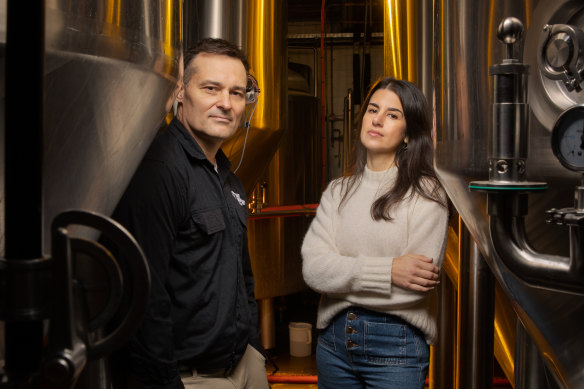
After Dereck and Diti Hales, founders of Melbourne’s Bad Shepherd brewery, went into voluntary administration, they were contacted by several fellow brewers: “It turns out everybody else was putting on a brave face, too.”Credit: Simon Schluter
It’s a bitter, wintry Wednesday in suburban Melbourne, but inside the Bad Shepherd brewpub, “50 cent wing night” is going off. Patrons are loading up on fried chicken and lining up for pints of passionfruit sour ale and peanut butter porter. It’s a watering-hole scene of familiar frivolity and warmth, but there’s sadness here too, and anger. At least there is over in the corner where founders Dereck and Diti Hales are sharing not just loaded vegan nachos, but also the story of their struggling small business.
The couple come from successful commercial careers, Diti in corporate affairs and HR, Dereck in finance and marketing, responsible for multimillion-dollar budgets. Dereck started home-brewing for fun in 2010, won an amateur brewing prize in 2012, and kept working his nine-to-five while interning with brewers before meticulously planning their brewery’s grand opening in 2015. The Cheltenham venue found an immediate growth trajectory and by 2019 was buzzing, with lines out the door and Bad Shepherd kegs and cans sold in more than 400 pubs, bottle shops and supermarkets around Victoria.
But things have been tough since 2022. We’ll get to the reasons why later, because the factors that led Bad Shepherd to the brink are not unique. Nor is its harrowing experience. “We’ve been operating in what feels like this no-oxygen zone for 18 months,” says Diti, shaking her head. “Conversations long into the night. Stress, emotions. A lot of ‘What did we do wrong?’ and ‘Why us?’ ” Dereck’s nodding along. “The hard part for us is that we’ve almost certainly lost our life savings. It’s gone,” he says. “There’s no way we’re walking away from this with a skip in our step. At best, no one will be chasing us.”
The drained couple offer strained smiles and rueful laughter. For a long time, they felt alone with their gallows humour and fight to stay afloat. That changed last October, however, once they waved the white flag. “The day we went into voluntary administration,” says Diti, “Dereck got calls from five other breweries – all asking the same thing: ‘Can we have the number of your administrator?’ The floodgates just opened.”
Bad Shepherd managed to keep most of its staff (albeit with a wage and hiring freeze), and its supplier accounts are current, but it’s only halfway through paying its debts. The couple have borrowed from family to staunch the bleeding and aren’t paying themselves, hopeful of hanging on through this financial year. “We didn’t know anyone else was struggling,” says Dereck. “But it turns out everybody else was putting on a brave face, too. We’re all in the same boat.”
Are they ever. The craft-beer sector is reeling. An estimated 22 breweries nationwide have either closed or entered voluntary administration in the past 12 months. And many believe the carnage is only starting – that the chill of the season will finish others off as drinkers stay home by the heater. The Independent Brewers Association (IBA) recently surveyed its members, and two-thirds said their brewery may not survive the economic downturn, replicating an ongoing collapse seen in both the US and UK.
Welcome to the rise and fall (or stall) of the craft-beer boom – a reckoning described by one beer blogger as “the shakeout we had to have”, and by others as a rationalisation “far more brutal than anyone imagined”.
The causes are many, from the pandemic to inflation and the cost-of-living crisis. There have been own goals, too, like rapid over-expansion or risky attempts at trading nationally, and the creation of too many increasingly inventive/ridiculous brews (Belly Button Beer, anyone, in which the yeast strain was grown from the navel lint of the brewer?) instead of beers that taste, like, well, beer. (Some go so far as to say craft brewers just didn’t prioritise the flavours savoured by the average beer drinker – and are paying the price for that hubris.) But they also face an unfavourable taxation system and powerful duopolies not just in brewing but retail, too. The issue – much like a fine saison, dubbel or weizenbock – is complex.
But before we mop the blood off the brewery floor, let’s revisit the early aughts, when Australia was represented by the almost homogenous offerings of Carlton & United Breweries (Carlton Draught, Victoria Bitter, etc) and Lion Australia (XXXX, Tooheys and more). This is back when Crown Lager was considered sophisticated.
“Beer had lost its personality and flavour,” says brewing consultant Nick Boots, the former general manager of Stone & Wood (which was later bought by Lion). “It was boring. That was the instigator of the craft wave. It drove the boom.”
A few independents already existed, like Matilda Bay, Mountain Goat and Little Creatures (all of which are now owned by the above duopoly), but in 2003 craft beer was less than 1 per cent of the industry, with only a couple of dozen microbreweries across the country. By 2023, it was 8 per cent of the market, and involved almost 700 brewers. “It happened so fast – the growth was insane,” says British journo and beer buff James Smith, who in 2010 launched The Crafty Pint online magazine. “For 100 years, beer had been lager – straightforward and simple – then suddenly it became this fascinating thing.”
Brewers were copying European styles such as Belgian browns and German hefeweizens, while a modern craft revolution was happening in America, producing an array of challenging sours and juicy, hazy, hop-heavy India Pale Ales with cult followings.
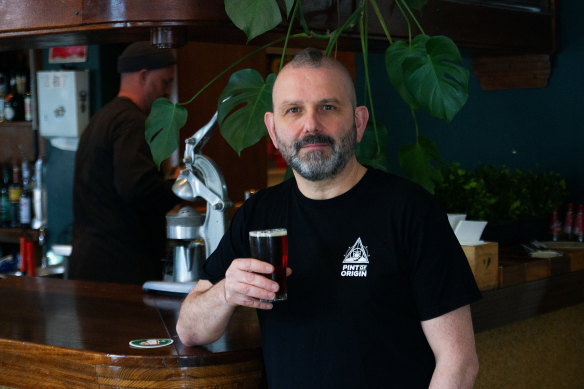
Crafty Pint’s James Smith says the growth of microbreweries was “insane”.
To be clear, Australians were (and still are) drinking less overall – between 1975 and 2020, our average pure alcohol per capita consumption dropped from 13 litres to 10.1 litres – and beer took the greatest tumble, from 9.2 litres down to 3.5 litres. But a discerning drinker was also emerging, one who wanted beers that were local and fresh, with authenticity and provenance.
The internationals took note and started making acquisitions. Asahi swallowed CUB, along with Green Beacon, Pirate Life, Balter, Four Pines and more. Kirin grabbed Lion, plus Byron Bay Brewing, James Squire, White Rabbit and others. You read that correctly: two Japanese conglomerates now own more than 80 per cent of beer sold in Australia – everything from Emu Bitter to Swan Draught.
Boozers wised up, seeking artisanal quality in a can – chasing flavour and falling for the stories behind craft brewers. They were willing to pay, too, giving rise to the “premiumisation” of the beer experience. “I love the smile great beer puts on people’s faces,” says Peter Philip of Wayward Brewing in Sydney’s Camperdown, who began brewing after selling his superannuation-related IT business. “Nobody at a dinner party ever said, ‘Peter, tell me a little more about that computer project you’re working on.’ ”
By late 2019, his brewery along the inner west “ale trail” was growing at an annual rate of 35 per cent –“tiger-by-the-tail sort of stuff” – and that’s when the coronavirus pandemic struck. Yet COVID-19 wasn’t quite the killer you might expect. JobKeeper helped, of course, but consumers did, too.
Australians endured lockdown by drinking locally, and drinking lots. “They were stuck at home with money in their pocket,” says Smith, “and would drop $15 on a can because ‘this is my treat.’ ”
I was one of them, hitting the suburban cellar in my face-mask on a Friday night, using my discretionary spending on a few intriguing new beers. Rainbow Sherbet Sour. I guess? Hazy Orange Creamsicle IPA. Why not? Rocky Road Campfire Chocolate Smoked Stout. Who are you to judge?
Craft brewers couldn’t sell their kegs to closed pubs, of course, so other expansions became necessary, from upgraded canning lines to new warehouse storage. “The demand skyrocketed but, in hindsight, it was not completely real,” says Dereck Hales of Bad Shepherd, “and we got caught out.”
After the lockdowns were lifted, the economic downturn bit into brewer profits on every front. Wages rose through inflation, hitting small brewers harder than large ones with their economies of scale. (One brewer suggests that to make 1000 litres of beer at his small brewery requires a similar amount of labour to that needed to make 50,000 litres at a largely automated facility.)
Ingredients became more expensive, with high-quality hops, malt and barley going up by about a third, too – the latter soaring even higher due to the war in Ukraine. The price of CO2 rose by about 50 per cent in one year alone. Energy costs soared, with one brewer in South Australia seeing his power bill more than double – leaping from $237,000 to almost $600,000 last financial year. Rent was an issue for many: some states had stopped landlords from raising rent during COVID, but once that moratorium ended, they went whack.
For Matt McIvor, co-founder of Brisbane’s Range Brewing, transport was one of the biggest hikes. His brand has two strong venues in Queensland, but its Abbotsford taphouse in Victoria just closed. When we meet at its farewell party on a Saturday arvo in June, the DJ decks are thumping, so the only quiet space is the cool room, where we can see our own breath. “Moving product costs us $100 more per palette, which doesn’t sound like much, but when you send three or four palettes to Melbourne every week, it’s a lot of money over the course of a year,” says McIvor. “We just can’t eat that expense.”
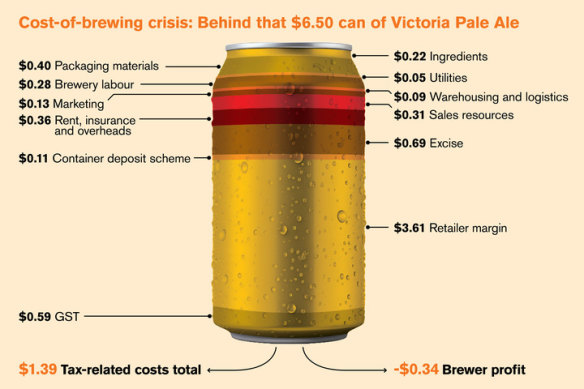
Credit: Ollie Towning
But the biggest expense for every brewer is tax, specifically excise, which increases twice yearly (linked to inflation). It’s an old law from the time of temperance, and taxes brewers based on alcohol volume. “It’s basically a sin tax, and it’s the third-highest in the world [behind Norway and Finland],” says Peter Philip, of Wayward.
Late last year Philip decided to use his product to explain the inequity, releasing “Recession Ale” – a crisp beer that wouldn’t intimidate drinkers, at an affordable price, and he broke down the cost of each can, right there on the can itself. Packaging (71 cents), brewery overheads (67 cents), retailer profit margin (40 cents), raw materials (32 cents) and finally taxes ($1.02 – an entire third of the retail price). The graphic design on the front? A piggy bank being smashed and raided … by the taxman. (All beer is taxed in this way, but the big conglomerates can absorb the cost more easily. More on how below.)
“You look at social media and people say, ‘Craft beer is so expensive!’ Well, there it is, right there on the can. What’s left for us is maybe 1 per cent profit,” says Philip. “Taxes should be levied on profits – they shouldn’t be something that makes you unprofitable.”
The Australian Tax Office wasn’t unsympathetic either, offering a lifeline to breweries by allowing them to defer their gargantuan excise obligations during the pandemic. But when the bill came due, the devastating new normal of the economic downturn was already here, and many brewers couldn’t service what they owed. Nor could they pass on the cost by raising the price of their already high-end offerings.
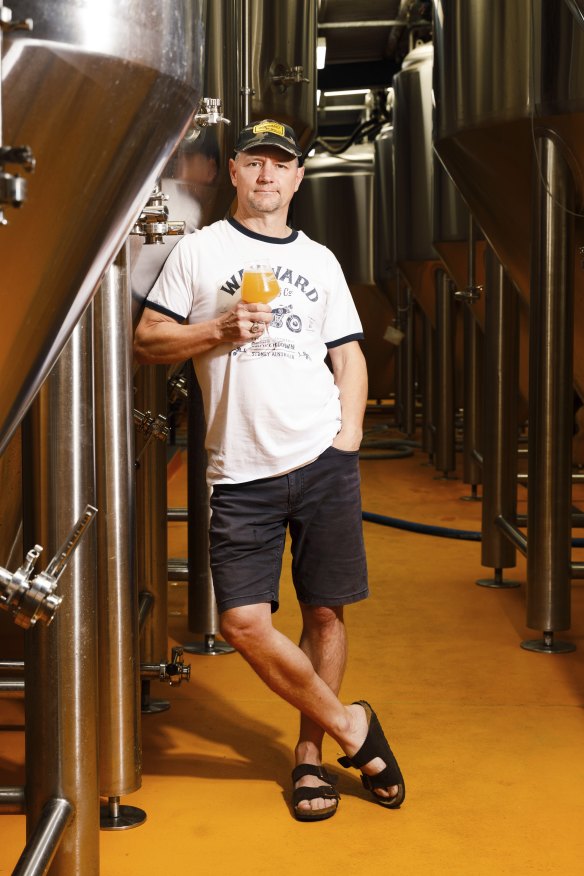
Peter Philip sold his IT business to start Wayward Brewing.Credit: Max Mason-Hubers
The whole issue of taxation rankles the beer sector even more so because the wine industry is taxed differently. The wine equalisation tax is not based on liquid volume but on wholesale price, making pinot and chardy far more affordable. “It’s also why you can get two litres of cask wine – which is stronger than beer – for $10,” says Kylie Lethbridge, CEO of the Independent Brewers Association. (Craft spirits are taxed under the same framework as beer, which is why boutique Aussie gin and whiskey are so expensive per bottle, and why distillers are similarly struggling.)
Wine overtook beer as Australia’s beverage of choice around 2015, but you wouldn’t know it to look at the recent federal budget, where revenue derived from alcohol was about $8.7 billion in total, with $2.7 billion coming from beer and just $1.1 billion coming from wine. “All we’re asking for is an equal playing field,” Lethbridge says. “Just make it fair.”
I almost forgot, there’s one more fee that burns every brewer – a new one, from the recent expansion of the container deposit scheme. You know the scheme: pop into a recycling centre, get 10 cents for every empty can and bottle, and do some good for the planet. Win-win, right?
Not if you’re a craft brewer like Mazen Hajjar of Hawkers brewers in Melbourne, who produces 11 million litres of beer a year. Because for every can and bottle sold, brewers pay about 16 cents towards the scheme’s administration costs and mandatory registration fees, meaning every slab they ship costs them an additional three-and-a-half bucks. “And the kicker?” adds Hajjar. “Wine doesn’t have to pay that, either. They’re exempt.”
‘All we’re asking for is an equal playing field. Just make it fair.’
Kylie Lethbridge, CEO of the Independent Brewers Association
Nevertheless, there are corrections required from the crafters. Many suspect, for instance, that the cult of craft beer peaked during the pandemic, perhaps earlier. Jack Roebuck, 31, is beer buyer at Footscray bottle shop and bar Mr West, and has the high-waisted pants and resplendent curling moustache of a guy who knows his brewskies. When he started at First Choice Liquor 13 years ago, there were maybe 30 different beers for sale. Now he runs a store that sells up to 500 different “SKUs” (stock-keeping units), as they’re known in the biz. “There was this thing in the States called ‘SKUmageddon’, which was, basically, too many options for punters,” Roebuck explains. “They didn’t know where to place their attention, so they just stopped paying attention.”
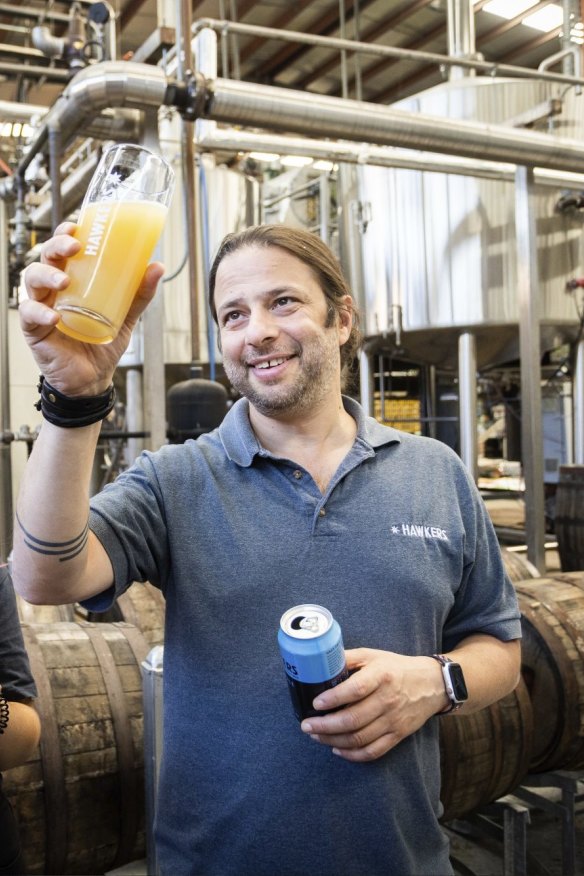
Hawkers Beer co-founder Mazen Hajjar.Credit: Paul Jeffers
Mr West, in fact, produced a 2019 collaboration beer called “Peak Hype” with local brewer 3 Ravens. It poked fun at the rampant proliferation of beer styles, and the way IPAs (India Pale Ales) were tweaked to become DIPAs (Double IPAs), then TIPAs (Triple IPAs), then WCIPAs (West Coast IPAs), then NEIPAs (New England IPAs), by coming up with their own tongue-in-cheek beer style. Their acronym? TCDHWGSCBBMOCSNEIPA.
“It stands for Triple Cryo Dry Hopped Wine Grape Skin Contact Barrel Blended Milkshake Oat Cream Sour New England India Pale Ale,” Roebuck says. “That was kind of us just getting silly.”
Behind that silliness there’s wisdom, however, at least according to people like Atle Crowe-Maxwell, managing director of DBA Reconstruction and Advisory. The registered liquidator points out that while he’s sometimes able to reset struggling breweries (by way of restructuring, and paying creditors cents on the dollar), he can’t reset the market. That’s already shifted.
Crowe-Maxwell paints a picture of a Friday night in the brewpub, and the beer is flowing but the tab is growing, and growing. “And that’s just not where people are right now,” he says. “People aren’t drinking hazelnut chocolate porter and eating smokehouse food. They’re drinking Carlton and eating Maccas.”
Speaking of Carlton, we’ve only touched on that Japanese duopoly – the one you support every time you buy a Boags, Hahn or Great Northern, a Fosters, Fat Yak or Furphy. Because if there’s anything squeezing small brewers as much as taxes, it’s the elephants in the room.
There’s a great scene in series two of the sitcom Colin from Accounts, when a fictional sales executive from Lion Australia – a big swinging dick named Jared – meets the protagonist of the show, craft brewer Gordon. Jared wants to buy Gordon’s brewery, but Gordon resists, so Jared turns cool, describing Gordon’s bleak future. “You’re a polar bear on a bit of ice.”
Gordon rages in response: “Yeah, and you’re f---ing climate change, mate!”
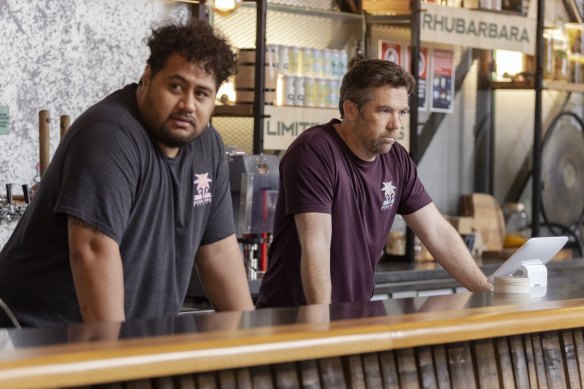
Patrick Brammall (right, pictured with Michael Logo) plays Gordon, a struggling microbrewer, in Colin from Accounts.
A spokesperson for Lion Australia tells Good Weekend that discretionary spending, increased costs and taxes have hit all brewers hard – and indeed there have been swingeing staff cuts at the big brewers. They also maintain that the beer industry has “never been more competitive”.
That’s a nod to the running complaint that this duopoly pushes strict and anticompetitive tap contracts within pubs and bars, effectively locking little brewers out of venues and limiting consumer choice. Here’s how it works, at least according to investigations by the Independent Brewers Association. A sales rep from a big brewer comes into a pub with a contract in hand. They offer generous rebates on their kegs – as long as they’re guaranteed 80 per cent of the taps (or more) and as long as the publicans hit volume targets. (The latter, perhaps intentionally, nudges publicans to remove independent taps.)
The ACCC looked into these practices in 2017, giving tangible hope to the craft industry. But the resulting report found an environment “unlikely to substantially lessen competition”, a crushing blow for the little guys. “We thought we were heading in the direction of democratising beer,” says one brewer, “and then we got this whiplash from the ACCC.”
There’s still hope, however, after a new report by the House of Representatives’ economics committee this year, which found that the “enormous market power” of the big brewers didn’t pass the pub test (pun intended). As Assistant Competition Minister Andrew Leigh has put it: “Australians are paying too much for a schooner.”
The federal government has urged the ACCC to re-investigate, so the independent brewers have been busily working on a new submission, gathering examples of tap contracts with ever more brazen inducements, like big cash kickbacks and trips to the Formula 1 Grand Prix in Monaco. They’re also worried by exclusionary stipulations, like telling a publican they can have two independent beers on tap – just as long as they don’t stock the most competitive regional brewer or the popular craft brewery around the corner.
“We’re also getting reports all around the country that salesmen for the multinationals are going in with lawyers to some regional RSL in the middle of nowhere and demanding that their one remaining independent tap be surrendered,” says the IBA’s Lethbridge. “People are telling us they feel intimidated by heavy-handed tactics.”
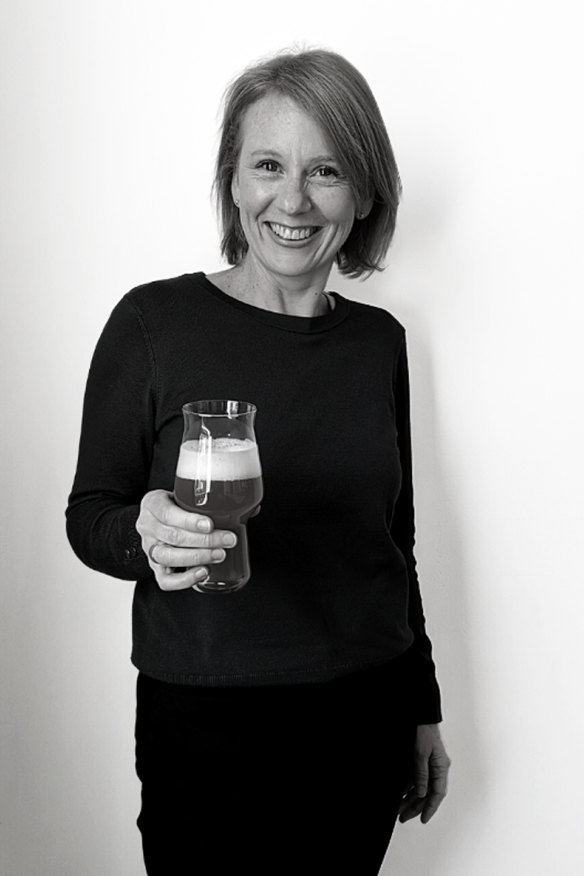
The IBA’s Kylie Lethbridge says the craft brewing industry “isn’t just guys with man buns and baseball caps having fun”.
While not addressing the standover accusations directly, the big brewers say their commercial arrangements are driven by customer demand. A spokesperson for Lion also notes that the company “celebrates the diversity and interest that craft brewing has ignited in the broader beer category”.
Meantime, the crafties are scrambling for whatever “pourage” is left, and that’s where the economics really get ugly. Just ask Ben Kraus, who founded Bridge Road Brewers in Beechworth in 2005, and sits down now at their new beer hall and restaurant in Brunswick, filled with warm wood and beige leather and bright brass taps.
The way Kraus explains it, hundreds of little breweries are left scrapping against one another for too few taps. With so much competition, many end up pricing their kegs too low, sometimes for little more than $200, a rate at which almost all brewers would lose money. “You don’t have small wineries trying to sell their wine for less than a bottle of Yellowtail, but that’s what brewers are doing,” Kraus says. “And the race to the bottom isn’t working out – that’s pretty bloody clear.”
Selling beer at a loss is hard to grasp, but if it gets your product into enough venues, it could be part of an overall exit strategy. “Maybe they want to have brand presence, and disrupt the big guys enough to get bought out,” Kraus says. “If so, I reckon you’re better off putting your money on the Melbourne Cup.”
‘The retailers realised they could sell their own “faux craft” beer, produced en masse but marketed otherwise.’
Dereck Hales, Bad Shepherd co-founder
As if that weren’t enough, brewers are also stymied by alcohol retailers, again dominated by two players. First there’s Endeavour Group (which was spun off by Woolworths in 2021 and owns Dan Murphy’s and BWS), then there’s Coles (which owns Liquorland, Vintage Cellars and First Choice). As the craft-beer sector grew, these retailers recognised the market and became beer producers in their own right, giving rise to the practice of “craft washing”.
Consider the home-brand products on supermarket shelves – butter, milk, sugar – and how they’re marked as such. There’s no such clarity with the beers they stock. If you step into Liquorland for a slab of Tinnies or buy a six-pack of Zytho from BWS, you might think you’re supporting an independent brewer, but they’re manufactured respectively for Coles and Endeavour. “The retailers basically got their act together and realised they could sell their own ‘faux craft’ beer, produced en masse but marketed as otherwise,” says Dereck Hales. “All at the expense of the brewers who’ve created this market.”
These kinds of private label beers offer the appearance of something authentic – in some cases, even creating websites with hokey-blokey origin stories – leading the ACCC to send cautionary notes about misleading labelling. But they’re also offering a cheap and palatable product for buyers seeking a return to inexpensive and non-threatening pilsners and lagers – something independent brewers would admit they were slower to embrace.
Two years ago, for instance, the IBA’s “Indies” awards didn’t even have a “champion lager” category. (They do now.) “For a while there, everyone was producing the funkiest thing they could, and you got reports that ‘craft beer tastes like washing liquid’ or ‘It’s green,’ ” Lethbridge says. “It captured the ‘beer geek’, but it didn’t bring the regular beer drinker along.”
All of which funnels neatly into what’s become a bit of an image problem for craft brewers. Visit any online story about the ailing industry (pun also intended), and the first thing you notice is a distinct lack of sympathy in the comments. These brewers, they say, have been making “dogshit beer” for too long, and people have finally gotten over the “wank factor”. Some express sympathy (“Very sad”) but most do not (“Fingers crossed they all go under”). It makes some sense given the characterisation of brewers in popular culture.
Take Seth Rogen’s belligerent man-child from the Apple TV+ series Platonic – a scooter-riding Millennial, more concerned with the art of the brew than the art of the deal. Or take the aforementioned Gordon in Colin from Accounts, who drives a vintage car and lives in a hipster apartment, but can’t remotely manage his life. A stunted adolescent and a lovable loser.
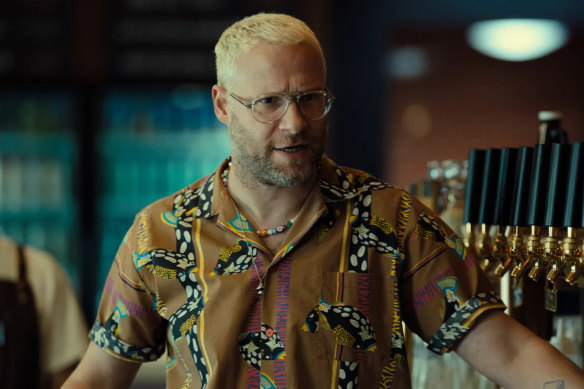
Seth Rogen as the man-child brewer in Platonic.
Lethbridge doesn’t disagree. Her association is trying to shift that narrative, from the imagery they use on promotional materials – now emphasising women and families in the industry – to working with TAFEs and universities around the country, for instance, to create higher certifications, because being a good brewer means being a scientist, safety expert, logistics specialist, and more. “We have to change the perception of who we are,” she says. “We’re doing everything we can to be taken seriously as an industry that is not just guys with man buns and baseball caps having fun.”
Jayne Lewis helped create Australia’s first female-founded brewery, Two Birds, back in 2010, and admits such depictions aren’t inaccurate. “If you ask anyone on the street to describe a brewer, it’s probably going to be ‘a beardy dude with tattoos’,” she says. “In fact, that’s what I would describe.”
The part that’s not accurate is the bit about them all “having fun” – at least not after what Lewis has seen in her new role. Two Birds was eventually sold and then wound up in late 2023, so Lewis now runs a consultancy, Full Colour Life, often advising brewers suffering from burnout. “You disappear into it at times. It can be all-consuming, if you allow it to be,” she says, speaking from experience. “It would drain me to the point where I was exhausted and cranky, just a shell. It’s a horrible, insidious thing.”
All of which is a shame, given the good these small businesses can do. They might account for only eight per cent of the market, but it’s still a billion-dollar contribution to the national economy. With more than 8000 employees combined, craft brewers also make up more than half of all employment in the beer sector.
They connect with communities, too, many brewpubs offering “karma kegs”, where they tap into a keg and the funds go to a charity. “We host a hop festival and a cycling event in Beechworth,” says Kraus. “We had 1080 riders last year. That many visitors to a town of 4000 is a massive contribution to the community.”
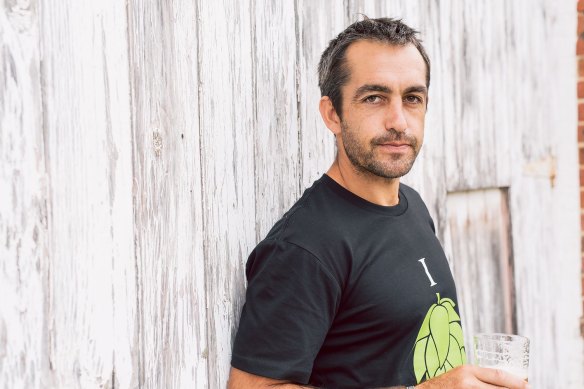
Bridge Road Brewers founder Ben Kraus says small breweries have to battle for a slim chance of being served on tap in pubs.
New breweries tend to revitalise areas, too, helping gentrify industrial neighbourhoods. A brewer moves in and a coffee-roaster isn’t far behind; a barbecue joint next. “When we moved into Reservoir, there was no one here,” says Hajjar. “You came here to buy drugs or get into a gang fight. Now, there’s a steel artist over here, a cafe down there and a gym around the corner.”
What happens next is anyone’s guess. Some brewers – like Wayward – are partnering with other breweries to create “beer cooperatives”, utilising shared spaces and networks to overcome disadvantages based on size. Philter in nearby Marrickville decided to face their challenges by crowdfunding new support. (They released a prospectus this year and raised $2.2 million – $200,000 more than they sought – by selling a stake to 1296 investors, who contributed anywhere from $250 to $100,000 apiece.)
There’s some consolidation, too, with a handful of healthy breweries buying up a second brand: Rocky Ridge Brewing Co in Margaret River, for instance, just bought Thunder Road Brewing in Brunswick, allowing for bicoastal production and distribution.
The big adaptation made by Moon Dog Craft Brewery in Melbourne was – shock horror – moving away from beer with the introduction of its alcoholic seltzer brand, Fizzer. (RTDs – “ready to drink” mixed-spirit cans – have surged in popularity, from 10.8 per cent of Australians drinking them pre-pandemic to 21 per cent today.) “It took us something like eight years to get to a million litres of beer,” says Moon Dog’s Karl van Buuren. “It took six months to get to a million litres of Fizzer. It’s half of our market now.”
Focusing squarely on venues is probably the safest play right now though because the margins are so much greater when pouring your own product in your own taproom. Experts believe the present path to survival is staying small – savouring that role as the village brewer – and pressing pause on dreams of large-scale production facilities. “Pull your wings in,” they advise, “and weather the storm.”
It’s too late for some, however. At 10am on a frigid Wednesday in June, the wrought-iron gates of Deeds Brewing in Glen Iris, Victoria, are locked. The only sound is that of a power drill being used to mount a “FOR SALE” sign on the brick wall of the brewery.
That’s the sad reality facing my local suds-slinger and its co-founder Patrick Alé (pun coincidental). After 12 years and countless beers, Alé now has to leave the formerly derelict sawtooth building that he brought back to life. (The refurbished property is listed on the market at $12 million.) He has to farewell staff who feel like family. The former engineer will need to sell all the brewing and packaging equipment, too, and say goodbye to the millions of dollars personally invested.
He would love for someone to come in and buy everything, including the brand and its intellectual property, so the label and all its recipes can live on. (I would, too. His award-winning “Survivor Type” Hazy Triple IPA is an all-time great beer.)
But the market’s tough. Instead, Alé will probably brew a final handful of limited-edition beers while he still has the keys to the brewery. Maybe he’ll open the taproom for one last hurrah. And then? “Then we move on to” – he pauses – “I don’t know what.”
To read more from Good Weekend magazine, visit our page at The Sydney Morning Herald, The Age and Brisbane Times.